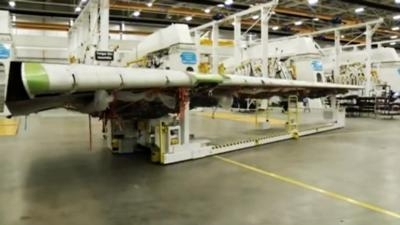Wings Being Joined To Static Test Airframe
The cockpit and all fuselage sections for the CSeries aircraft’s first flight test vehicle (FTV1) have arrived at Mirabel, Québec, and that the assembly of FTV1 is in progress. Additionally, the first wings for the all-new CSeries aircraft are now being mated to the test airframe that will be used during the Complete Airframe Static Test (CAST), Bombardier announced Monday. The company also said that testing of the avionics, electrical, flight control, fly-by-wire, hydraulic, landing gear and wiring systems for the CSeries aircraft, as well as virtual flights, are progressing steadily at Mirabel on ‘Aircraft 0’ - the on-the-ground Integrated Systems Test and Certification Rig (ISTCR) for the CSeries aircraft.

Located at the company’s Experimental Test Facility in St-Laurent, Québec, the CAST is designed to demonstrate the static strength of the airframe and show compliance with certification requirements. The Mirabel facility will be the production site for the CSeries aircraft and the assembly process will include a fully automated moving line using the latest lean manufacturing principles.
“The CAST, FTV1 and ‘Aircraft 0’ are all key elements in the testing and development of the CSeries aircraft," said Rob Dewar, Vice President and General Manager, CSeries, Bombardier Commercial Aircraft. “Aircraft 0 is permitting us to validate the CSeries aircraft’s systems in an efficient, on-the-ground setting that allows us to work seven days a week and 20 hours a day. Our findings will allow us to optimize the time spent in the flight test program. The integrated systems tests on ‘Aircraft 0’ are designed to mitigate risks and provide the necessary reliability before first flight. To date, tests have shown no unexpected results and all is going as planned.”
With regard to the wings for the CSeries aircraft, Mr. Dewar commented: “Subsequent to the extensive research and test program at Bombardier Aerospace Belfast, which was used to optimize the final production design for weight and performance for the wings, the CAST will be used to confirm their static strength along with that of the other components of the airframe.”
The CSeries aircraft wings were built at Bombardier’s new manufacturing and assembly facility in Belfast, Northern Ireland, which is responsible for the design, manufacture and integration of the advanced composite wings for the CS100 and CS300 jets, including all flight control surfaces and high-lift systems.
The use of resin impregnation has enabled the manufacturing of larger and more complex composite structures in the aviation industry. Bombardier Aerospace Belfast has been at the forefront of that manufacturing revolution, developing and patenting its unique Resin Transfer Infusion (RTI) process that is now being used in manufacturing the primary structural components of the wings for the CSeries aircraft. The use of composites in such a large structure as the wing provides weight savings, but additional benefits to customers include fewer inspections and therefore lower maintenance costs, thanks to the corrosion resistance properties and fatigue strength of the composite material. The composite manufacturing process being employed at Bombardier Aerospace, Belfast also permits a high degree of accuracy and aero smoothness to minimize drag and therefore reduce the CSeries aircraft’s fuel burn.

The advanced technology, carbon-fibre wings for both the CS100 and CS300 aircraft have an approximate area of 1,209 square feet, and a span of 115' 1". While some of the internal parts for the wings of the two models will be different, they have the same aerodynamic profile. During the CAST, the wing and other components of the airframe will be subjected to a series of load cases – representing flight manoeuvres, landing, take-off and other in-flight and on-ground conditions - to test the strength of the airframe. For selected load cases, internal cabin pressure will also be applied when simulating in-flight conditions. Data collected will be monitored by Bombardier’s stress engineers, as well as by the partners and suppliers that are involved in the development of structural components for the CSeries aircraft.
Bombardier Belfast manufactured the centre fuselage for FTV1, while the forward and aft fuselage sections, as well as the cockpit, were supplied by Bombardier’s St-Laurent facility. The rear barrel was supplied by Shenyang Aircraft Corporation (SAC), a subsidiary of the state-owned aviation industrial entity, China Aviation Industry Corporation (AVIC).
As in the production of the wings for the CSeries aircraft, Bombardier has capitalized on its expertise in composites technology in the development of the airliner’s aft fuselage. For the carbon-fibre aft fuselage, including the pressure dome, the company is utilizing Automated Fibre Placement (AFP) techniques. Bombardier's adaptation of AFP technology, which is also utilizing robotic technology, has benefited from the largest collaborative aircraft structures demonstration project initiated by Canada’s National Research Council to advance AFP use in the aerospace industry.
Bombardier is employing a brand new moving line in manufacturing the cockpit for the CSeries aircraft at its St-Laurent facility. The line has been designed using lean manufacturing principles in order to ensure safety for the company’s employees, enhance product quality and provide flawless execution for on-time delivery.
(Top image from Bombardier YouTube video. Bottom image CSeries artist's concept)
 ANN's Daily Aero-Term (04.20.24): Light Gun
ANN's Daily Aero-Term (04.20.24): Light Gun Aero-News: Quote of the Day (04.20.24)
Aero-News: Quote of the Day (04.20.24) ANN's Daily Aero-Linx (04.21.24)
ANN's Daily Aero-Linx (04.21.24) Aero-News: Quote of the Day (04.21.24)
Aero-News: Quote of the Day (04.21.24) ANN's Daily Aero-Term (04.21.24): Aircraft Conflict
ANN's Daily Aero-Term (04.21.24): Aircraft Conflict




